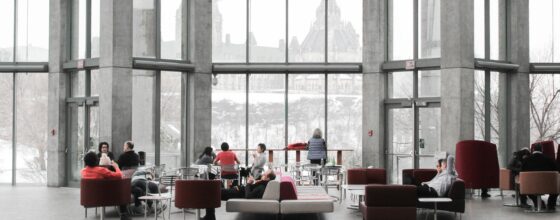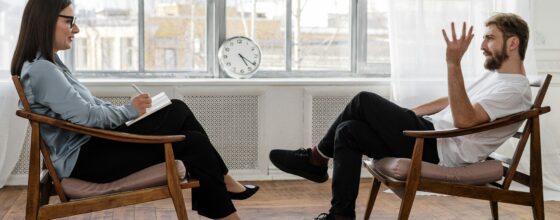Workplace Trends with Liz Elam

Air quality as a human right, designing for the neurodiverse, and pushing the boundaries of design to enhance the workplace experience is the focus of Season 1 of our newly launched GCUC podcast – Workplace Trends with Liz Elam. The podcast will be released quarterly in “seasons” and in our first five episodes, we interviewed mavens from across the globe on all things Design.
Here are some of our favorite moments…
It’s all about the experience. Design is like a good wine. You have the first sip and its wow, really impactful then there’s nothing there; that wine isn’t particularly good. Then you have a great wine, it lingers, the length of the finish and the complexity of what you taste just gets better and better. – Larissa Murphy, Co-Founder at Contrast
I see it and my skin crawls. If I could get rid of the term ‘open office’, I would. We in our industry really suck at terminology; we all use it differently. Open plan, no. Open environments, yes. – Kay Sargent, Senior Principal & Director of WorkPlace at HOK
Technology can increase your productivity, but the tool is only one thing. What we really should be striving for and what I became enthusiastic about is realizing the potential of human beings. – Philip Vanhoutte, Founder at Ozadi
The International WELL Building Institute is leading the global movement to transform our buildings, our communities and organizations in ways that help people thrive. The WELL building standard is focused exclusively on the way that buildings, communities, and everything in them can improve our comfort, drive better choices, and generally enhance and not compromise our health and wellness.– Tori Shepherd, WELL Faculty, LEED GA
For that knowledge worker cohort, the real challenge is going to be when a portion of each organization heads back into the office, how to get the balance between the work from home or work from anywhere component and the in office component. How to make sure that we learn everything that we could do from this unique moment in time and make those experiences great as we bring a portion of the workforce back in the office. – Melissa Marsh, Founder and Executive Director at PLASTARC
When people arrive and they go in you have the wow factor of the arrival space but then you go down long, endless corridors. It just feels oppressive and to work in those kinds of environments must feel oppressive.– Larissa Murphy, Co-Founder at Contrast
One in eight people is considered neurodiverse but if you include depression, that number skyrockets. People are feeling depression and anxiety 3 to 4 times higher in 2020 than in previous years. – Kay Sargent, Senior Principal & Director of WorkPlace at HOK
We asked the associates if they were happy with the space provided to work and the majority of the answers coming back were the acoustics of the space were very very poor and we must fix that. – Philip Vanhoutte, Founder at Ozadi
I have really been able to throw myself into work and many people would say we have been incredibly busy but incredibly passionate. There’s never been more focus on health and wellness in the built environment so I am happy to be contributing in a way that might give some options once out of the current state and perhaps change the future of the world. – Tori Shepherd, WELL Faculty, LEED GA
We are so thankful for being able to be knowledge workers when we have so many frontline workers and so many other folks who don’t have the leisure to be able to be doing their work in such flexible environments. – Melissa Marsh, Founder and Executive Director at PLASTAR
Ergonomics is the study of efficiency of human beings in a workspace. Every person is unique and individual so there is no one hard fast rule of what works for one person works for everybody. That is a lot of where our workspaces go wrong. – Larissa Murphy, Co-Founder at Contrast
The number one lifestyle risk is stress and threat and that’s impacting work. The thing we pay the least amount of attention to is stress and in the US it’s like a badge of honor. – Kay Sargent, Senior Principal & Director of WorkPlace at HOK
During the pandemic, Lessman launched the Home Index so you can compare which things are best done at home vs the office. It is now abundantly clear and confirmed that 6 out of10 people do not have the accommodation to work productively at home. – Philip Vanhoutte, Founder at Ozadi
There’s never been a greater focus on air quality, and this is something that tenants are now demanding from their landlords. Very interestingly, HR professionals are getting involved with turning to engineers, facilities management teams and asking what MERV filtration level is the building using; it has a direct impact on the wellbeing of the employees which is what they oversee. – Tori Shepherd, WELL Faculty, LEED GA
A lot of things about digital security are more accomplishable and more secure than physical security. For a long time, organizations have falsely focused on physical security and not sufficiently focused on digital security. Looking at the financial sector for exemplar focus on digital security that could help provide a more secure environment if we focus on the digital component, no matter where you are. – Melissa Marsh, Founder and Executive Director at PLASTARC
We are always trying to design environments that better support people. It’s not one dimensional, it’s supporting people on every level with their physical health and wellbeing, mental health and wellbeing, more creative, more productive. The environment can make a massive contribution to society. – Larissa Murphy, Co-Founder at Contrast
We all have sensitivities to different stimulation, sound, noise, smells, touch. People that are neurodiverse tend to spike really high or really low, but we all have sensitivities, neurotypicals included. Most of us are grossly under aware. – Kay Sargent, Senior Principal & Director of WorkPlace at HOK
I am very pleased that WELL is keeping at it to keep it to make sure that certification becomes relevant and implementable. Affordable for small and medium spaces enterprises, residential and health. A building that people can be proud of, can work in, and be very productive. – Philip Vanhoutte, Founder at Ozadi
If you’re looking for a new office space or if you are a building developer, you want to seek out MERV 13 or higher. That MERV level is correlated with the capacity to filter specific sizes of aerosols or contaminants in the air. The higher the MERV level the more efficient the filtering will be. This can be integrated into the HVAC system directly or if you’re in an old, existing building that can’t be upgraded then you can use standalone filters. – Tori Shepherd, WELL Faculty, LEED GA
One thing this cohort is not going to give up on are some of these freedoms that have become associated either with this moment in time due to COVID and flexible working and working from home or advocacy around race and culture and ethnic identity and the flexibility that should come with that. – Melissa Marsh, Founder and Executive Director at PLASTARC
An easy solve is talking to people and understanding their perspective. We have this unique social, cultural, economic environment of the power of choice and the winners are really going to be those organizations that provide the most choice and flexibility and learn from there from their employees and customers. Treat your employees like customers with some of those get to know you experience analysis that are kind of commonplace in customer service but somehow, we forget to think about them in employee experience. – Melissa Marsh, Founder and Executive Director at PLASTARC
Click HERE to listen to Season 1 on Design of Workplace Trends with Liz Elam. It’s juicy!





